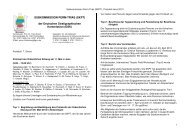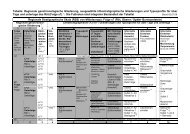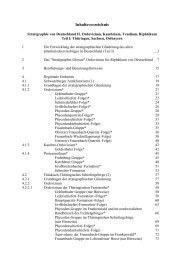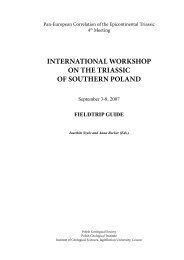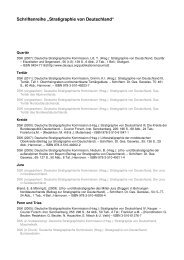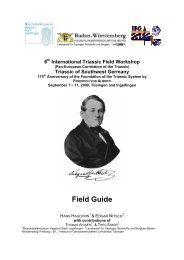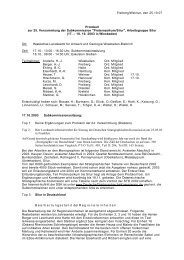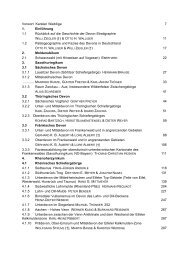International Field Workshop on 'The Triassic of eastern France'
International Field Workshop on 'The Triassic of eastern France'
International Field Workshop on 'The Triassic of eastern France'
Create successful ePaper yourself
Turn your PDF publications into a flip-book with our unique Google optimized e-Paper software.
4.2.6. Upper ‘Marnes irisées supérieures’ - Rhaetian minor cycle or Norian-Rhaetian Cycle<br />
This cycle started in the east with dolomitic playa deposits grading upwards into the restricted marine<br />
deposits <strong>of</strong> the Rhaetian Sandst<strong>on</strong>es which display some limited open marine influences within a<br />
transgressive trend (Fig. III.2, IV.1). The base-level fall is recorded in the upper part <strong>of</strong> the Rhaetian,<br />
characterized by the c<strong>on</strong>tinental deposits <strong>of</strong> the ‘Argiles de Levallois’. Because <strong>of</strong> the intra-’Marnes irisées<br />
supérieures’ stratigraphic disc<strong>on</strong>tinuity, this minor cycle lies directly up<strong>on</strong> the ‘Grès à roseaux’ - ‘Dolomie<br />
de Beaum<strong>on</strong>t’ minor cycle in the east (Fig. IV.1). Further west, the dolomitic coastal sabkha deposits grade<br />
laterally into alluvial plain sediments with fluvio-lacustrine sandst<strong>on</strong>es (‘Grès d'Egrenay’, ‘Grès de Boissy’,<br />
‘Grès d'Etrechy’) where no classical Rhaetian facies are recognized (Fig. IV.6).<br />
E-W correlati<strong>on</strong>s show that the ‘Rhaetian’ boundary is a diachr<strong>on</strong>ous facies boundary between a<br />
coastal sabkha and a restricted marine envir<strong>on</strong>ment within a base-level rise (Bourquin and Guillocheau,<br />
1993; Bourquin and Guillocheau, 1996, Figs. III.2). In the southeast <strong>of</strong> the basin, the Rhaetian Sandst<strong>on</strong>es<br />
may have eroded the ‘Marnes irisées supérieures’ deposits locally.<br />
Figure IV.6: (A) Maps <strong>of</strong> retrogradati<strong>on</strong>al phase <strong>of</strong> the Norian-Rhaetian cycle (denoted d, Fig. III.2). (B) Maps<br />
<strong>of</strong> the base <strong>of</strong> the Rhaetian sandst<strong>on</strong>es for the wells located in the <strong>eastern</strong> part <strong>of</strong> the basin to the top <strong>of</strong> the<br />
<strong>Triassic</strong> (end <strong>of</strong> retrogradati<strong>on</strong>al phase and progradati<strong>on</strong>al phase <strong>of</strong> the Norian-Rhaetian cycle (denoted e,<br />
Fig. III.2). See Figs. III.2 and IV.1 for key. After Bourquin et al., 2002.<br />
35



